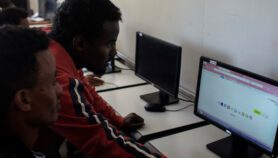By: David Dickson
Send to a friend
The details you provide on this page will not be used to send unsolicited email, and will not be sold to a 3rd party. See privacy policy.
Science communication has become a major factor in the formulation of policy on science-related issues, not just a commentary on the way such issues are addressed.
One of the most significant images in UK debates over the past 20 years about the relationship between science and society was a photograph taken in May 1990 of Britain's then agriculture minister, John Gummer, feeding a hamburger to his somewhat bemused and reluctant daughter, Cordelia.
The country was at the time in the midst of its crisis over so-called Mad Cow Disease, but the government — prompted by the farming industry — was insisting that there was no way that the disease could pass to humans. The photograph encapsulated the headlines that went with it, indicating that a government minister was so confident about this position that, even as a responsible parent, he was prepared feed British beef to his daughter.
The rest, as they say, is history. It was not long before Gummer, and indeed the whole of the British government, had to eat its words — almost literally — and admit that they had got it wrong; BSE indeed can pass into the food chain, with tragic consequences. Furthermore this particular picture has come to haunt Gummer — who ironically has a good record as an effective defender of the environment — the Conservative party and government public relations officers ever since.
With the benefit of hindsight, the manipulation is obvious. We are now well aware of the function of this image as well as the dubious claim to scientific legitimacy on which it was intended to be based. Indeed the subsequent realisation by the British public of the extent to which it had been misled by this particular picture, and indeed the whole government handling of the BSE debacle in Britain, is widely blamed for a significant drop in the public's trust of both politicians and the scientists who advise them.
But the picture also highlights a critical issue about the way that the media frames, and thus helps to mould, public perceptions of key issues at the interface between science and society. The issue for those involved in science communication, both in developed and developing countries, is how to balance a desire to inform the public about the scientific perspective on controversial issues — such as BSE or genetically-modified crops — with an awareness of the political interests that may lie on each side of such a dispute.
The challenge for society more generally is to recognise that the practice of science communication has become a significant participant in the formulation of policy on science-related issues, and no longer merely provides a commentary on the way such issues are addressed.
Beyond the respect for truth
At its crudest level, of course, science communication must be concerned with the accurate transmission of information. This includes not only communicating the facts produced by science, but equally reporting as accurately as possible on the uncertainties attached to such knowledge, as well as on the impacts of science on society — and society's response to such impacts. All this is relatively conventional wisdom with the science communication community, even if it acknowledges a truth — that achieving a proper public understanding of science is a two-way process that must include the scientist's better understanding of the public — that is only just being recognised within the scientific community itself.
To quote the words of Alan I. Leshner, for example, the chief executive office of the American Association for the Advancement of Science, writing in a recent issue of Science: "We need to engage the public in a more open and honest, bi-directional dialogue about science, technology and their products, including not only their benefits but also their limits, perils and pitfalls. We need to respect the public's perspective and concerns, even when we do not fully share them, and we need to develop a partnership that can respond to them."
But there is a need to go beyond this, and to inquire how the process of developing a partnership with the public works in practice, and who will be engaged in establishing it. Here it is necessary to acknowledge that the role of the science communicator, as Leshner accepts, is not one of simply conveying the 'truth' to the public (any more than the role of a scientist can be defined simply as discovering scientific 'facts'). Rather it is to communicate significant facts — and, where space allows, the nature of this significance.
In other words, the task of any science communicator is essentially one of extracting significance from a mass of scientific evidence, policy documents, and headline-grabbing statements from individuals and institutions that may or may not have a vested interested in the outcome. In doing this, I suggest, those engaged in the communication of science — particularly when this is conceived of as a two-way process — becomes proxies for the public when it comes to interpreting and articulating the relationship between science and society, or to put it another way, between knowledge and power.
Science communication and policy-making
The terms 'interpreting' and 'articulating' are both somewhat abstract concepts. They imply that the way the media handles science has actually become an important constitutive component of the policy-making process on science-related issues. The media does more than just report policy choices to the public on such issues, or even on the responses of the public to the policy choices they are being presented with. In a significant way the media also helps to frame both the policy issues and the public responses to them.
This is illustrated by the intense debates taking place in the developing world over topics such as GM crops or even 'biopiracy', itself a term largely coined by those who might be described as communicators of science. In each case, the way that such issues are presented to the public becomes the way that the issues are seen by the public. And these perceptions in turn become a major factor in political decision-making, particularly in an era when mass communication has made every decision taken by a politician the subject of close public scrutiny.
The full implications of this shift remain far from clear. Nevertheless it is already possible to suggest that informed communication about science must become a central component of development strategy. Without such communication, trust in political decisions on science-related issues will be gradually dissipated. With such communication there is no guarantee that this trust will necessarily be maintained. But at least the basis will have been laid on which such trust can be rebuilt.
This comment is based on a talk delivered to the annual meeting of American Association for the Advancement of Science on 17 February 2003 in Denver Colorado
© SciDev.Net 2003













